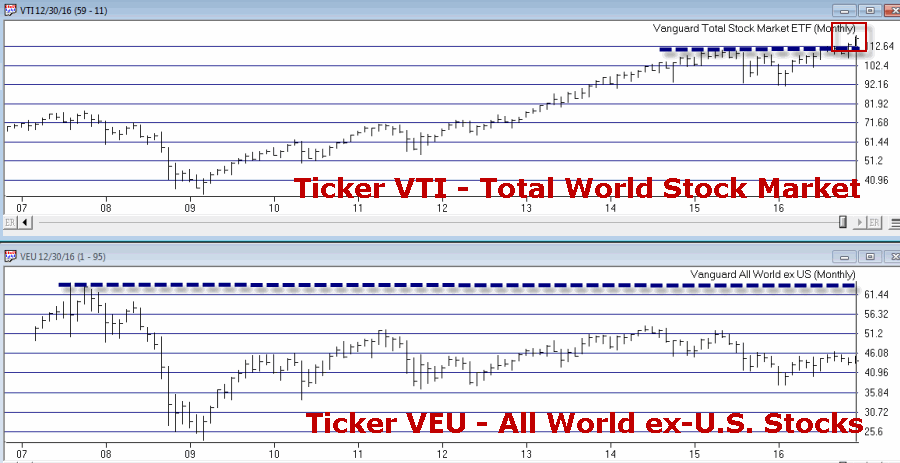In my last piece I note that the U.S. stock market presently stands alone in terms of recent performance. While virtually every major U.S. stock market average has run to new highs in the last several weeks, not one other individual country has really even come close. While this might induce spontaneous chants of “USA, USA”, the truth is that this may not necessarily be a good thing.
(Please see also The One Asset Class Per Month Strategy)
This current disconnect will likely be resolved in one of two ways:
A) The USA will drag the rest of the world screaming and kicking to enjoy in our newfound prosperity (assuming of course that we finally stumble upon that actual newfound prosperity that the stock market is telling us we should be celebrating).
B) The USA fails to pull up the rest of the world and the US stock market gets “dragged down” with the rest of the world’s bourses.
This is the part in the article where a skilled market analyst would offer up a clear and concise opinion of what will happen next and why. And if one happens to stop by the office in the next few minutes or so I will ask him or her what they think. All I know is that at the moment the US stock market is in an uptrend and that the majority of the rest of the world’s stock markets are fair to middling at best (with many looking much worse).
Until something changes I will stick to the US market, thank you very much.
A Little “Worldly” Perspective
What follows is essentially the world (stock markets) in pictures. The purpose is simply to provide you with some perspective regarding the state of the markets around the globe.
The key thing to note is:
*Figure 1 shows U.S. stocks making new highs
*Figures 2 through 6 show the rest of the world’s stock markets lagging far behind
Click Figures 1 through 6 to enlarge
 Figure 1 – U.S. Stocks soaring to new highs (Courtesy AIQ TradingExpert)
Figure 1 – U.S. Stocks soaring to new highs (Courtesy AIQ TradingExpert)
 Figure 2 – My Own Index of Single Country ETFs; -17% below 2014 high (Courtesy AIQ TradingExpert)
Figure 2 – My Own Index of Single Country ETFs; -17% below 2014 high (Courtesy AIQ TradingExpert)
In Figures 3 through 6 note that the overall “stock market malaise” is not limited to one portion of our earth, but rather stretches pretty far East, West, North, South and pretty much all points in between.
 Figure 3 – Middle East Stocks; -40% below 2007 high (Courtesy AIQ TradingExpert)
Figure 3 – Middle East Stocks; -40% below 2007 high (Courtesy AIQ TradingExpert)
 Figure 4 – European Stocks; -36% below 2007 high (Courtesy AIQ TradingExpert)
Figure 4 – European Stocks; -36% below 2007 high (Courtesy AIQ TradingExpert)
 Figure 5 – Asia-Pacific Stocks;-17% below 2014 high (Courtesy AIQ TradingExpert)
Figure 5 – Asia-Pacific Stocks;-17% below 2014 high (Courtesy AIQ TradingExpert)
 Figure 6 – North/South America Stocks; -22% below 2011 high (Courtesy AIQ TradingExpert)
Figure 6 – North/South America Stocks; -22% below 2011 high (Courtesy AIQ TradingExpert)
Wishing you (please choose any or all of the following that are applicable):
*Merry Christmas
*Happy New Year
*Happy Holidays
*Joy
*Peace on Earth
*[Some other phrase that you do not find offensive here]
Jay Kaeppel












